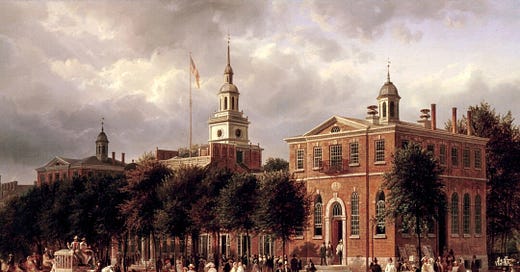“Independence Hall in Philadelphia,” 1858, by Ferdinand Richardt. Oil on canvas. White House. (Public Domain)
Saving Independence Hall
[click to read]
Today, it’s hard to imagine a visit to Philadelphia without a stop at Independence Hall. Constructed from 1732 to 1753 by Edmund Woolley and Andrew Hamilton, the fine Georgian building became the birthplace of America’s independence. Both the Declaration of Independence and the U.S. Constitution were debated and ratified in the historic Pennsylvania State House.
With its brick façade, bell tower, and steeple, the iconic tower not only graces our currency, it has inspired replicas across the country. The 20th-century American architect Jens Fredrick Larson popularized the Colonial Revival architectural in his college designs found throughout America.
Independence Hall suffered severe deterioration in the decades following America’s Revolution. As early as 1781, the original clock tower became badly rotted and was demolished and replaced with a simple hipped roof and a small spire. By the 19th century, Independence Hall and its tower were fated for demolition. However, a visit by the Marquis de Lafayette may have saved Independence Hall from being erased from history. (read more)
“Mount St Michael, Cornwall,” 1830, by Clarkson Frederick Stanfield. Oil on canvas. National Gallery of Victoria. (Public Domain)Clarkson Stanfield
Clarkson Stanfield
[click to read]
While thumbing through an old volume of Charles Dickens stories, my attention was caught by an exquisitely rendered illustration: the woodcut of a belfry and doorway from the “The Chimes.” At the bottom of the illustration was the tiny signature by C. Stanfield R. A. (read more)






